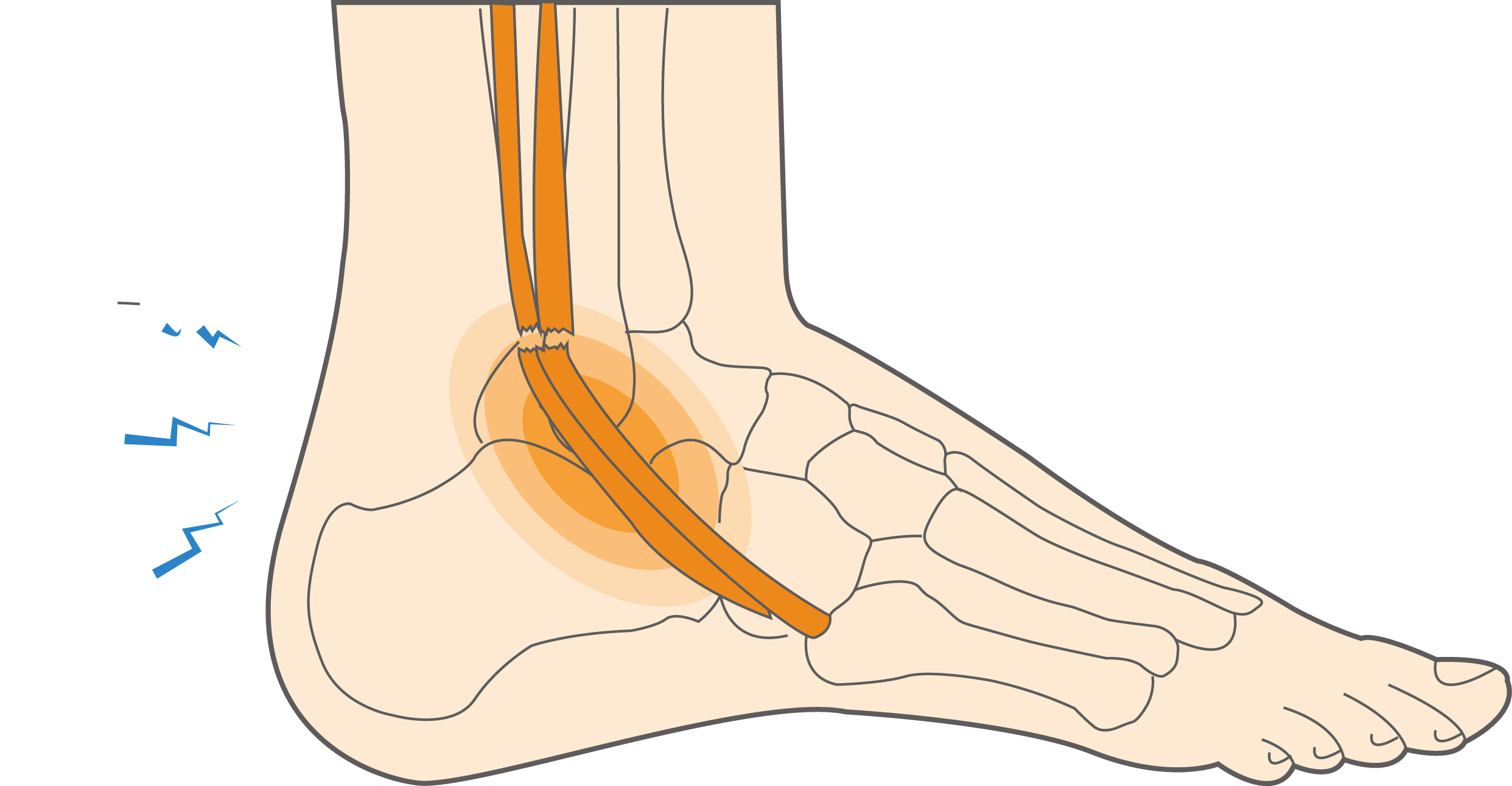Tendons are strong, fibrous tissues that connect muscle to bone. There are two peroneal tendons that run behind the bony bit on the outside of the ankle. They connect the ankle and foot to the muscles in your lower leg and play an important role in ankle stability when changing direction or pushing off with the toes. These tendons can become inflamed or torn due to overuse or injury.
Peroneal Tendon Tear Causes, Symptoms & Treatment Options
Tendons are strong, fibrous tissues that connect muscle to bone. Two peroneal tendons run behind the bony bit on the outside of the ankle. They connect the ankle and foot to the muscles in your lower leg and play an important role in ankle stability when changing direction or pushing off with the toes. These tendons can become inflamed or torn due to overuse or injury, leading to outer or lateral ankle pain and potentially even a tendon rupture.
Overview
Overview

What causes Peroneal Tendon Tear?
Peroneal tendon tear and peroneal tendonitis are often seen in athletes who play sports requiring them to run and jump. The injury can result from a sudden twisting motion or lateral ankle sprain that stretches the ankle’s outer ligaments too far. This can result in the tearing of the tendons. Overuse of the tendons is another common cause, usually due to running on uneven surfaces, wearing poor running shoes, or chronic ankle instability from an ankle sprain or other injury. Symptoms can include lateral foot pain,lateral ankle pain, ankle swelling, and pain that worsens with activity.
Peroneal tendonitis or tears are most common in these sports:
- Soccer
- Football
- Basketball
- Running
- Dancing
- Volleyball
Symptoms
Peroneal tendonitis is often associated with burning pain along the outside of the foot, ankle, and lower leg that increases with activity and decreases with rest. Peroneal tendon tears have similar symptoms to tendonitis but athletes may also experience a sharp, tearing kind of pain.
Common symptoms may include:
- Pain along the outer side of the ankle
- Pain that is more pronounced when stretching the foot inwards or turning the foot outwards
- Swelling
- Warmth and tenderness to the touch on the outer side of the ankle
- Weakness and/or instability of the foot
When to see a doctor
Peroneal tendon injuries can get worse without timely treatment, so it is important to see your doctor if you experience symptoms associated with peroneal tendonitis or a peroneal tendon tear. Your doctor will ask questions about your injury, its symptoms, and the type of sports you play. A physical examination will be conducted to look for signs of pain, swelling, tenderness, and weakness. Your doctor may gently move your ankle to see what positions cause pain. Imaging tests, such as a magnetic resonance imaging (MRI) test, may be ordered to get a clearer picture of the extent of the damage to your tendons.
Non-operative treatment
In mild to moderate cases, peroneal tendonitis is usually treated non-surgically. Treatment will start with taking a break from activities that cause ankle pain. Athletes should consult with their doctor about modifying their activities (e.g. running on different surfaces) or substituting other activities that place less stress on the peroneal tendons, such as swimming. Other conservative treatment options include:
- Immobilizing the ankle with a cast or splint
- Icing for 20 minutes every two to three hours
- Elevating the ankle
- Compression with an Ace bandage for swelling
- Taping to improve stability
- Nonsteroidal anti-inflammatory drugs (NSAIDs), such as ibuprofen and naproxen, to relieve pain
- Physical therapy exercises
- Corticosteroids (anti-inflammatory medicine) to relieve pain
Try these exercises to help address your condition:
Below is a PDF of the Exercise Program
Surgical Treatment
For more severe injuries, such as a partial peroneal tendon tear, your doctor may recommend surgery to repair your tendons or address other issues identified during the diagnosis. Your doctor will advise if surgery is an appropriate treatment option for you.
Recovery
Recovery from peroneal tendonitis/tear will depend on the extent of your injury and type of treatment you receive. With minor injuries that are treated non-operatively, athletes usually recover in four to six weeks. After surgery, athletes can expect to be limited to non-weight bearing activities for approximately six weeks, and full recovery may take three to six months. Physical therapy will help you gradually return to weight-bearing activity and ultimately accomplish a full return to play.
GET BACK TO WHAT YOU LOVE. FASTER
Sources
https://www.acfas.org/open-peroneal-tendon-stabilization-with-fibular-groove-deepening-summary
http://www.sportsinjuryclinic.net/sport-injuries/ankle-achilles-shin-pain/peroneal-tendonitis
https://viewmedica.com/vm/index/brochure/68/peronealtendonitis/en
https://dermalmedix.com/foot-tendon-functions/
Frequently Asked Questions
How is a peroneal tendon tear diagnosed?
Diagnosis typically involves a physical exam and imaging tests like MRI or ultrasound to detect signs of tendon rupture, inflammation, or degeneration.
Can a peroneal tendon tear lead to chronic ankle instability?
Yes. Untreated tears can weaken ankle support, resulting in recurring sprains and long-term instability.
What’s the difference between peroneal tendonitis and a tear?
Tendonitis refers to inflammation, often from overuse, while a tear involves actual tearing of the tendon fibers. Both can cause outer ankle pain and lateral foot pain.
What treatments are available for a tendon rupture?
Severe tears or tendon rupture may require surgical repair. Recovery includes immobilization, and rehab to restore strength and function.

